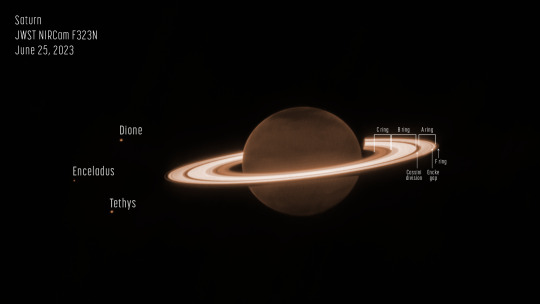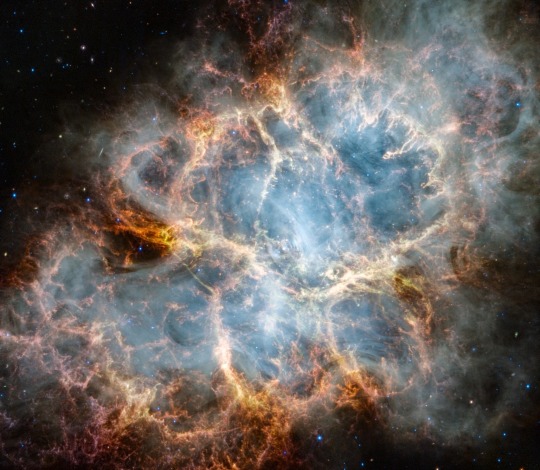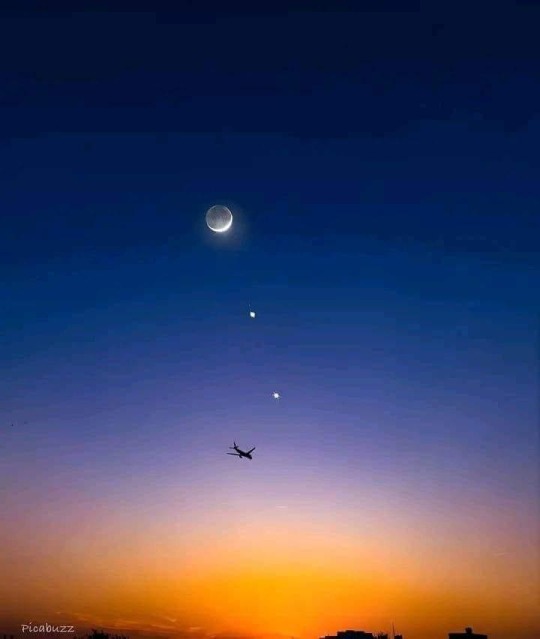#webb discovery
Explore tagged Tumblr posts
Text

Often the search for answers leads to new questions. Still, astronomers did not expect to find the familiar shape of a question mark in the latest image from the James Webb Space Telescope.
A natural but rarely seen distortion of space is causing one dusty red galaxy to appear multiple times, raising the question that maybe such distortions are not as rare as originally thought: https://webbtelescope.pub/4cGUNpi
#space#astronomy#stsci#science#nasa#universe#nasawebb#james webb space telescope#webb discovery#webb images#webb telescope#webb#unfold the universe#galaxies#question#question mark
45 notes
·
View notes
Text

#nasa#james webb space telescope#jwst#webb telescope#webb discoveries#james webb discoveries#jameswebbtelescope#astronomy#saturn#infraredimage
185 notes
·
View notes
Text

Here’s a stunning image of the sun taken by the James Webb Space Telescope!
The black dot you see is actually Mercury!
James Webb Space Telescope Discoveries
#space#space photography#space images#sun#planet mercury#stunning#james webb space telescope#feel free to share/reblog#James Webb Space Telescope Discoveries (Facebook)
119 notes
·
View notes
Text

NEW DISCOVERY FROM 2022-Patchick-Strottner-Drechsler 3 in Andromeda
⚠️Remember to click on all photos to view in full stunning quality
#self discovery#space travel#astronomy#nasa#astronomers#universe#nasa photos#astrophotography#outer space#astrophysics#nasawebb#hubble space telescope#international space station#space exploration#space#space science#james webb space telescope#space program#science#space photography#nasa science#science facts#planetary science#astronomy facts#planetary nebula#nebula#our universe#the universe#nasa astronauts#nasa picture of the day
81 notes
·
View notes
Text
The celestial object of the day is El Gordo!


This galaxy cluster is located 7 billion light-years away from Earth, and it formed when the universe was only half the age it is currently. Its ginormous mass (2.1 quadrillion solar masses) helps scientists see galaxies that are very far away thanks to gravitational lensing
#Image credit: NASA/ESA/SOAR/CSA#One of the telescopes that helped its discovery was Chandra#Thank Chandra!! Cool as always#astronomy facts#astronomy#astrophotography#outer space#space#nasa#nasa photos#science#space exploration#space photography#celestial object of the day#james webb space telescope#jwst#jwst images#esa#astrophysics#chandra x ray observatory#El Gordo#galaxy cluster
44 notes
·
View notes
Text

Crab Nebula, taken by the James Webb Space Telescope’s NIRCam (Near-Infrared Camera) & MIRI (Mid-Infrared Instrument)
Published by NASA 10/30/23
#photography#space#telescope#james webb space telescope#nebula#crab nebula#universe#stars#infrared#astronomy#galaxies#discovery#science#nasa
101 notes
·
View notes
Text

Moon Jupiter and Venus in assembly (James Webb Telescope Discoveries)
* * * *
hymn to time :: ursula k. le guin
Time says “Let there be” every moment and instantly there is space and the radiance of each bright galaxy.
And eyes beholding radiance. And the gnats’ flickering dance. And the seas’ expanse. And death, and chance.
Time makes room for going and coming home and in time’s womb begins all ending.
Time is being and being time, it is all one thing, the shining, the seeing, the dark abounding.
[via "Alive On All Channels"]
#James Webb Telescope Discoveries#Moon#Jupiter#Venus#the heavens#Alive On All Channels#Ursula K LeGuin#time#time and space#coming and going#space
20 notes
·
View notes
Text








OC paintings so far! They are all based on something space related!
Left to Right:
James Webb (JWST), Trappist (TRAPPIST-1), Spitzer (SST), Chandra (CXO), Discovery (Space Shuttle), Habex (HabEx concept), Lynx (Lynx concept) and Luvoir (LUVOIR concept)
I have more ocs I plan to paint! Hubble and Origins are on the top of my list right now. Hope some of you might be interested to see them!
I also like talking about my ocs so if you want, you can ask me questions about them, or talk to me about anything space related because I love space!
#oc#original character#character design#character art#james webb#trappist#spitzer#chandra#space shuttle#discovery#habex#lynx#luvoir#my art#digital art#xenon art#space
82 notes
·
View notes
Text
Scientists are studying massive, dusty clouds of gas surrounding newly formed stars. The gas is the basis of planet formation. Electric Magnetic Disk Winds and Thermal Winds from the star affect how solar systems form.
How ice forming in the outer layer of the protoplanetary disk formed on space rocks affects the building of planets.
Along with how close the observation lines up with the theories of how planet building is done.
#astrophysics#astronomy#james webb space telescope#nasa#science article#discovery#physics#solar system#planets
5 notes
·
View notes
Text

Astronomers using NASA’s James Webb Space Telescope (JWST) and Chandra X-ray Observatory have discovered LID-568, a low-mass supermassive black hole that emerged 1.5 billion years after the Big Bang. This black hole exhibits super-Eddington accretion, feeding at a rate 40 times higher than the theoretical limit, where gravitational pull and radiation pressure reach equilibrium. Its immense outflows disrupt its host galaxy, preventing the accumulation of matter needed for star formation.
LID-568’s rapid growth defies conventional models, challenging theories that suggest sustained accretion is essential for supermassive black hole formation. By revealing how short bursts of intense feeding can drive such rapid development, this discovery offers critical insights into black hole formation and galaxy evolution in the early universe.
#general knowledge#affairsmastery#generalknowledge#current events#current news#upscaspirants#upsc#generalknowledgeindia#upsc current affairs#upsccoaching#upscpreparation#upsc2025#world news#news#technology#breaking news#tech#techinnovation#technews#outer space#space#planet#astronomy#galaxy#cosmos#black hole#james webb space telescope#james webb telescope#chandra x ray observatory#discovery
5 notes
·
View notes
Text



Went on a cute little date with my better half yesterday ♥️ I love her so much ♥️
@weirdcreature28 ♥️
#we watched madame Webb#it was awesome!#she also bought me some clothes from discovery#I love her!#my babygirl
16 notes
·
View notes
Text
The Space Telescope Science Institute's Dr. Macarena Garcia Marin talks about the James Webb Space Telescope's recent groundbreaking discoveries.
#space#astronomy#stsci#science#nasa#universe#nasawebb#james webb space telescope#webb telescope#jwst#science discovery#discoveries#astrophysics#wenn
24 notes
·
View notes
Text
The James Webb Space Telescope has just unveiled mind-blowing details of Messier 106

The James Webb Space Telescope has just unveiled mind-blowing details of Messier 106, one of our cosmic neighbors! 🌌 Located 23 million light-years away, this spiral galaxy is revealing secrets like never before.
🔭 What’s New?
A supermassive black hole at its heart, actively devouring gas & dust.
Mesmerizing "anomalous" arms made of hot gas, visible in X-rays & radio waves.
Vivid colors showing the galaxy’s intricate gas and dust distributions.
Dive into the mystery of Messier 106 and explore the unseen depths of our universe! Learn more - https://www.jameswebbdiscovery.com/discoveries/james-webb-telescope-unveils-hidden-details-of-neighboring-galaxy-m-106 #JamesWebb #NASA #Messier106 #SpaceExploration #Astronomy
#JamesWebb#NASA#Messier106#SpaceExploration#Astronomy#webb discoveries#james webb space telescope#jwst#james webb discoveries#webb telescope#esa#jameswebbtelescope
71 notes
·
View notes
Text
"Looking deep into space and time, two teams using the NASA/ESA/CSA James Webb Space Telescope have studied the exceptionally luminous galaxy GN-z11, which existed when our 13.8 billion-year-old universe was only about 430 million years old."
"The formation of the first stars and galaxies marks a fundamental shift in cosmic history, during which the universe evolved from a dark and relatively simple state into the highly structured and complex environment we see today."
continue reading article
#astronomy#space#universe#galaxies#primeval galaxy#history#evolution#stages of development#james webb telescope#james webb space telescope#webb telescope#science#technology#discovery
12 notes
·
View notes
Link
Astronomy Daily - The Podcast: 17th September 2024 Welcome to Astronomy Daily, your go-to Podcast for the latest and most exciting developments in space and Astronomy. I'm your host, Anna, and I'm thrilled to bring you another episode packed with fascinating stories from the cosmos. Today, we've got a stellar lineup of topics that span from Earth to the far reaches of our galaxy. So strap in and prepare for liftoff as we journey through the universe's latest mysteries and marvels. Highlights: - Ariane 6 Rocket Update: Europe's newest rocket, the Ariane 6, made its inaugural launch on July 9th this year. Despite a successful series of trials, the mission ended with the upper stage coasting in orbit, unable to complete its final planned maneuver. ArianeSpace has traced this issue to a fixable software fault and is committed to staging a second mission before the end of the year. This rocket, developed at an estimated cost of €4 billion, aims to maintain Europe's competitiveness in the global launch market. - James Webb Space Telescope Discovery: The James Webb Space Telescope has identified a supermassive black hole that's starving its host galaxy, nicknamed Pablo's galaxy. Located 12 billion light-years away, this galaxy is in a quenched state, expelling gas at speeds of about 1000 km/second, effectively cutting off the galaxy's fuel for star formation. This discovery is a crucial piece of evidence in understanding how galaxies evolve over cosmic time. - US-Australia Spaceport Collaboration: The recent ratification of the US-Australia Technology Safeguards Agreement (TSA) opens up new possibilities for US companies to use Australian spaceports for launches and payload returns. Australia's vast uninhabited landscapes and less congested air and sea traffic offer unique advantages for launch and reentry. This collaboration could further strengthen strategic capabilities between the two nations. - New Mars Revelations: Recent gravity data studies have uncovered dense, large-scale features beneath Mars' surface, shedding light on the planet's geological history and volcanic activity. These findings suggest that Mars might still have active internal movements. Scientists are proposing the Martian Quantum Gravity (MaQis) mission to map Mars' gravity field in unprecedented detail. - This Week's Rocket Launches: SpaceX is gearing up for two Falcon 9 missions this week. The first launch from Cape Canaveral will carry a pair of Galileo global positioning satellites, while the second from Vandenberg Space Force Base will launch another batch of Starlink satellites, pushing the number of operational Starlink satellites past the 6000 mark. Rocket Lab is also preparing for an Electron launch from New Zealand, carrying the second batch of nanosatellites for Kinéis. For more space news, be sure to visit our website at astronomydaily.io. There you can sign up for our free Daily newsletter, catch up on all the latest space and Astronomy news with our constantly updating news feed, and listen to all our previous episodes. Don't forget to follow us on social media. Just search for #AstroDailyPod on Facebook, X, YouTubeMusic, and TikTok to stay connected with our community and never miss an update. And today's listener shout-out goes to EricG., a listener and commenter on Spotify. Thank you, Eric. Your kind words are much appreciated. This is Anna signing off. Keep looking up and I'll see you next time on Astronomy Daily. Sponsor Links: NordVPN NordPass Malwarebytes Proton Mail
#9#ariane-6-rocket#astronomy#black-hole#collaboration#discovery#falcon#james-webb-space-telescope#lab#mars-gravity-mapping#region#rocket#satellites#space#space-news#spacex#starlink#tharsis#us-australia#volcanic
2 notes
·
View notes
Text
Rare Six-Planet Star System Discovery is Music to Astronomers’ Ears - Technology Org
New Post has been published on https://thedigitalinsider.com/rare-six-planet-star-system-discovery-is-music-to-astronomers-ears-technology-org/
Rare Six-Planet Star System Discovery is Music to Astronomers’ Ears - Technology Org
A rare star system with six exoplanets has been discovered with an architecture unchanged for billions of years.
Exoplanet – illustrative photo. Image credit: Pixabay (Free Pixabay license)
The star, HD110067, that is 100 light-years away in the northern constellation of Coma Berenices, has been perplexing researchers for years. Now scientists, including those at the University of Warwick, have revealed the true architecture of this unusual system using NASA and ESA spacecrafts.
The first indication of planets orbiting the strange star system came in 2020, when NASA’s Transiting Exoplanet Survey Satellite (TESS) detected dips in the star’s brightness that suggested planets were passing in between the star and the TESS spacecraft. A preliminary analysis revealed two possible planets. One with a year (or an orbital period – the time it takes to complete one orbit around the star) of 5.64 days and another with an unknown period at the time.
Two years later, TESS observed the same star again. Analysing all data ruled out the original interpretation but presented two additional possible planets, changing the picture of the planetary system completely.
youtube
Much was still unknown about the planetary system, and that was when Rafael Luque of the University of Chicago and scientists across the world – including those at the University of Warwick – joined the investigation. They used data from the European Space Agency’s (ESA) CHaracterising ExOPlanet Satellite (CHEOPS), hoping to determine the orbital periods of these faraway planets.
The CHEOPS data was key in confirming a third planet in the system and the team had found the key to unlocking the whole system. It was now clear that the three planets were in a pattern of orbits known as an ‘orbital resonance’. For example, an outer planet takes 20.52 days to orbit, which is extremely close to 1.5 times the orbital period of the next planet with 13.67 days. This in turn is almost exactly 1.5 times the orbital period of the inner planet, with 9.11 days.
Thomas Wilson, Department of Physics, University of Warwick, said: “By establishing this pattern of planet orbits, we were able to predict other orbits of planets we hadn’t yet detected. From this we lined up previously unexplained dips in starlight observed by CHEOPS and discovered three additional planets with longer orbits. This was only possible with the crucial CHEOPS data.”
Orbitally resonant systems are extremely important to find because they tell astronomers about the formation and subsequent evolution of the planetary system. Planets around stars tend to form in resonance but can easily have their orbits thrown around.
For example, a very massive planet, a close encounter with a passing star, or a giant impact event can all disrupt the careful balance. As a result, many of the multi-planet systems known to astronomers are not in resonance meaning that multi-planet systems preserving their resonance are rare.
“We think only about one percent of all systems stay in resonance,” explains Rafael Luque. That why HD110067 is special and invites further study. “It shows us the pristine configuration of a planetary system that has survived untouched.”
“As our science team puts it: CHEOPS is making outstanding discoveries sound ordinary. Out of only three known six-planet resonant systems, this is now the second one found by CHEOPS, and in only three years of operations,” says Maximilian Günther, ESA project scientist for CHEOPS.
HD110067 is the brightest known system with four or more planets. Since those planets are all sub-Neptune-sized with likely larger atmospheres, it makes them ideal candidates for studying the composition of their atmospheres using the NASA/ESA/CSA James Webb Space Telescope and the ESA’s future Ariel telescope. Whereas ESA’s upcoming PLATO telescope, due to be launched in 2026, within which the University of Warwick is playing a leading role, could find planets in this system with even longer years.
Thomas Wilson added: “All of these planets have large atmospheres – similar to Uranus or Neptune – which makes them perfect for observation with JWST. It would be fascinating to test if these planets are rocky like Earth or Venus but with larger atmospheres – solid surfaces potentially with water. However, they are all much hotter than Earth, 170-530 degrees Celsius, which would make it very difficult for life to exist.”
“A resonant sextuplet of sub-Neptunes transiting the bright star HD 110067” by R. Luque et al. is published in Nature today. DOI 10.1038/s41586-023-06692-3
Source: University of Warwick
You can offer your link to a page which is relevant to the topic of this post.
#Analysis#architecture#Astronomy news#coma#Coma Berenices#Composition#data#Discoveries#ears#earth#ESA#European Space Agency#Evolution#exoplanet#Exoplanets#Featured Space news#form#Future#it#James Webb Space Telescope#jwst#life#Light#Link#Music#NASA#nature#One#orbit#Other
3 notes
·
View notes